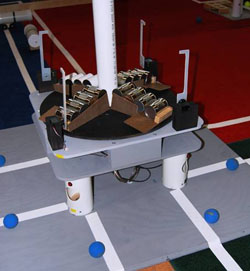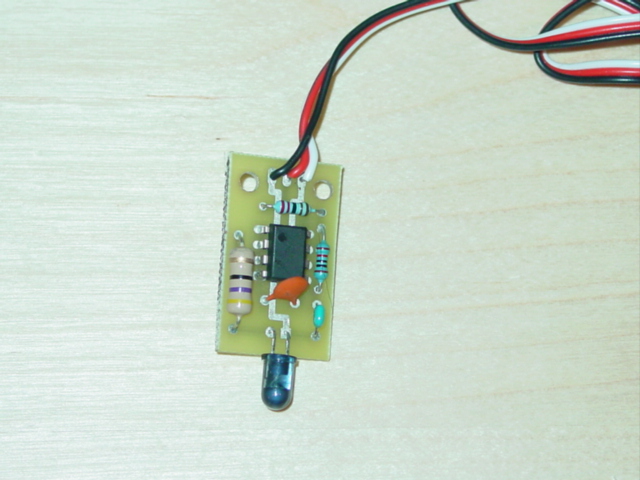Chemistry, base-4 point system, team inventories, automated/moving field, custom electronics, communication to the field, and ECOs….the 2009 High Octane game had it all and a number of firsts.
Designed by the Brazos BEST hub, the game theme was centered around chemical engineering and the refining and production of fuels.
The objective is for teams to collect and employ common molecules (carbon dioxide: CO2; and water: H20) and essential resources (energy, catalysts) to complete a series of chemical reactions. The elements needed for the reactions are distributed about the field and must be captured and returned to the processing plant to be used in the reactions. The eventual goal is to produce isooctane, or alternatively, the lesser valued naphtha. Intermediate products (ethylene, benzene) that are generated in the process are retained in the team’s inventory for later use.
Chemical Equations
The items collected had to be collected in the correct quantity and combination to complete a series of specific chemical equations. When an equation is completed, a secondary product is formed. That product is then used (in the proper quantities) in a next level chemmical equation. The process continues until the ultimate product, isooctane (C8H18) is produced.
During the seeding competition, teams will collect H20, catalysts, energy, and CO2 in an effort to synthesize ethylene (C2H4) according to the reaction equation:
(1) 2 CO2 + 2 H20 + Energy + Catalyst -> C2H4 + 3 O2 (waste product)
In other words, it takes two CO2 units, plus two H20 units, plus one Energy unit, plus one Catalyst unit to produce a single unit of ethylene and oxygen. In this scenario, oxygen is considered a waste product and does not contribute to the team’s inventory.
After acquiring ethylene through equation (1), or through commodity trading (described later), teams can synthesize benzene (C6H6) through the following equation:
(2) 3 C2H4 + Energy + Catalyst -> C6H6 + 3 H2 (waste product)
Teams can then choose to use the benzene to create either naphtha (C6H14) using equation (3), or the more valuable isooctane (C8H18) by using equation (4).
(3) C6H6 + 4 H2 + Energy + Catalyst -> C6H14
(4) C6H6 + C2H4 + 4H2 + Energy + Catalyst -> C8H18
For equations (3) and (4), water is used as the hydrogen (H2) source.
Base-4 Point System
Now this was a first for sure! Scoring points in base-4? Yes, all scoring was calculated in Base-4 numbering system. Scoring was based on current inventory of components.
The inventory that can be carried from one match to the next is strictly limited. No more than three units of each reactant/resource can be held in inventory from match to match. Components with counts in excess of four will be traded up for the next higher value component. The trading sequence follows the order from right to left in the table that follows.
| C8H18 | C6H14 | C6H6 | C2H4 | CO2 | Energy | Catalyst | H20 |
For example four units of water become one unit of catalyst. The trading sequence occurs after the reaction equations are applied starting with the equation (4) working in reverse order back to equation (1).
Team Inventories
Because teams were progressively “building” the chemical products, the resources collected were carried forward from match to match. This required that an inventory system be utilized so that teams could keep track of what resources and quantities they had collected and which ones they needed to collect in upcoming matches to achieve their next product. This required some major changes to the existing scoring software to include such a feature.
Automated/Moving Field
Many parts of the field were in motion. A dedicated BEST BRAIN microcontroller, the same as that used on the team robots, was integrated into the field to control all of the action. It was one of the most active games that BEST has ever had. The game development team did a fine job of raising the bar on technology and automation while keeping the design fairly simple and easy enough for hubs to implement.

Custom Electronics
IR transmitters distributed to teams, custom design by BEST just for this game. This was BEFORE the BEST IR sensor kit was introduced. These transmitters were very specially designed to interface to the BEST BRAIN through a servo port. Teams could generate different IR codes in their robot software to be sent to the field. Each code caused the field to react in a unique way.

Communication to the Field
IR receivers were built into the field, specifically the center platform accessible by all teams. There were 4 IR ports that teams could transmit to. The computerized field controlled various automation based on IR commands received from the robots. Receiving a code at a port would cause some action related to the game pieces near that port. This included release of game pieces, rotation of the center platform and movement of overhead (hanging) game pieces.
ECOs
High Octane was the first game to introduce the concept of an Engineering Change Order (ECO); that is, a predetermined rules change between hub competitions and the championships with the intent of ramping up the difficulty level. ECOs are quite common in industry and consist of changes that occur to a product that is past it’s critical design phase, sometimes even after it has been built. In the BEST Robotics case, it represented some rules changes that may cause teams to rethink their scoring strategy or even change parts of their design to create better opportunity for scoring.
